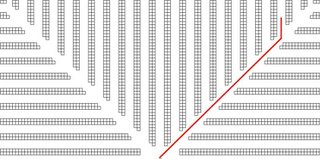What is a V-shaped cross aisle?
Our research began by asking the following simple question, "Why does it have to be straight?" -- meaning, why does a cross aisle have to be straight? Of course, the answer is, "It doesn't!" After some modeling and experimentation, we developed designs that look like the one above. On the left is a traditional warehouse; on the right, a warehouse with an optimal cross aisle. Expected travel distance to make a pick in this warehouse is 10% less than in the traditional warehouse, even accounting for the lost space due to inserting the cross aisle.
The main insight here is that the V-shaped cross aisle allows workers to travel into the picking space as quickly as possible, where they can then branch off and get their items. There are three travel paths: along the bottom aisle and up (this is the fastest way to get some items), along the cross aisle and down, and along the cross aisle and up.
We would like to hear your opinions on
1. Safety issues for forklift drivers. In particular, some picks would require workers to have to make more than a 90 degree turn (travel path #2 above).
2. Congestion concerns? How wide would the cross aisle have to be to remove this concern?
3. Would the reduced storage density ever be worth it? This design offers the classic tradeoff: lower labor costs for retrieval, in exchange for a slightly larger warehouse.
--Kevin

